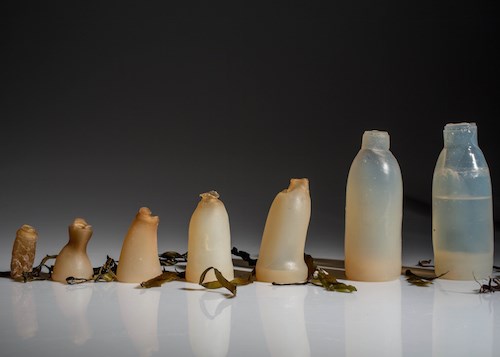Icelandic Design Student Creates 100% Biodegradable Bottle
Red algae powder combined with water forms a jelly-like material.
Red algae powder combined with water forms a jelly-like material.
A 100% biodegradable algae water bottle created by Ari Jonsson is featured in the March issue of Dezeen, a London-based architecture and design publication. Jonsson, a product design student at Iceland Academy of Arts, first presented his eco-friendly invention at DesignMarch, an annual design festival held in Reykjavik in mid-March.
He noted that he felt an “urgent” need to develop a replacement material after reading about the amount of waste plastic produced daily, particularly single-use products such as water bottles. He started by evaluating the strengths and weaknesses of different materials to determine what could be suitable for use as a water bottle and eventually came across a powdered form of agar—a substance made from algae.
When agar powder is added to water, it forms a jelly-like material. Once he determined the right proportions, Jonsson slowly heated the substance before pouring it into a bottle-shaped mold that had been kept in the freezer. He then rotated the mold while submerged in a bucket of ice-cold water, until the liquid inside took the shape of the bottle. It was then placed in a refrigerator for a few minutes before the agar bottle was extracted from the mold.
Here’s how it appears to work: while the bottle is full of water, it keeps its shape; and, as soon as it is empty, it begins to decompose. Jonsson said, “If it fails, or if the bottom is too thin or it has a hole in it, I can just reheat it and pour it into the mold again.” Now, here is the clincher: Because the bottle is made from 100% natural materials, the water stored inside it is safe to drink. However, Jonsson did report that after a while, it (the water) may extract a small amount of taste from the bottle. He went further noting that “if the user likes the taste, they can bite the bottle itself when they are finished drinking.”
According to the Dezeen article, designers are increasingly experimenting with seaweed and other forms of algae. For example, seaweed has been recently used as architectural cladding and to create lampshades, while algae has been the base material for a rug-weaving yarn and a textile dye. Algae has even been used as an energy source to power buildings.
Search for nearly 100,000 grades of polymers on the Universal Selector by clicking here
Related Content
-
Solve Four Common Problems in PET Stretch-Blow Molding
Here’s a quick guide to fixing four nettlesome problems in processing PET bottles.
-
Pregis Performance Flexibles: In the ‘Wow’ Business
Pregis went big and bold with investment in a brand-new, state-of-the-art plant and spent big on expanding an existing facility. High-tech lines, well-known leadership and a commitment to sustainability are bringing the “wow” factor to blown film.
-
US Merchants Makes its Mark in Injection Molding
In less than a decade in injection molding, US Merchants has acquired hundreds of machines spread across facilities in California, Texas, Virginia and Arizona, with even more growth coming.

















